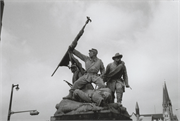Property Record
900 W WISCONSIN AVE
Architecture and History Inventory
| Historic Name: | The Victorious Charge |
|---|---|
| Other Name: | The Victorious Charge (Soldiers' Monument) |
| Contributing: | |
| Reference Number: | 79394 |
| Location (Address): | 900 W WISCONSIN AVE |
|---|---|
| County: | Milwaukee |
| City: | Milwaukee |
| Township/Village: | |
| Unincorporated Community: | |
| Town: | |
| Range: | |
| Direction: | |
| Section: | |
| Quarter Section: | |
| Quarter/Quarter Section: |
| Year Built: | 1898 |
|---|---|
| Additions: | |
| Survey Date: | 2001 |
| Historic Use: | statue/sculpture |
| Architectural Style: | NA (unknown or not a building) |
| Structural System: | |
| Wall Material: | Metal |
| Architect: | John S. Conway |
| Other Buildings On Site: | |
| Demolished?: | No |
| Demolished Date: |
| National/State Register Listing Name: | Not listed |
|---|---|
| National Register Listing Date: | |
| State Register Listing Date: |
| Additional Information: | A 'site file' exists for this property. It contains additional information such as correspondence, newspaper clippings, or historical information. It is a public record and may be viewed in person at the Wisconsin Historical Society, State Historic Preservation Office. 2001- "The Victorious Charge is one of four monuments found within the Court of Honor landscaped median, which spans the 800 and 900 blocks of West Wisconsin Avenue in downtown Milwaukee. The statue is oriented east and located at the western end of the median by the intersection of North 10th Street and West Wisconsin Avenue. This median is approximately 28' wide and the setting is urban with Wisconsin Avenue serving as a primary east-west thoroughfare in the City of Milwaukee. Designed by John Severinus Conway and cast in bronze at the Fond Crescenzi Foundry in Rome, Italy, this 9' 10" statue rests on a square granite pedestal. The statue is composed of four soldiers and suffers from noticeable corrosion. Three of the figures are charging into battle while the last figure has fallen in front of his comrades, apparently mortally wounded. Of the three charging figures, the middle soldier stands with his legs spread apart and knees bent. With his right hand he clutches and raises a flag that features an eagle at the top of the shaft. In his left hand he grasps the end of a rifle, which has been broken off above the handle. Historic photographs reveal that this rifle featured a bayonet and pointed toward the northeast. The soldier on the right stands with his left leg forward. His pistol is drawn in his left hand and his right hand holds the handle of a sword. The blade of the sword has been broken off above the handle. The soldier on the left stands with his right leg forward and grasps his rifle with both hands. The bayonet of his rifle has been broken off. Inscribed in the bronze by the southwest corner of the statue it reads: FOND CRESCENZI ROMA 1898. The square, granite pedestal features the inscription "TO THOSE WHO FOUGHT IN THE WAR FOR THE UNION 1861- 1865 ERECTED 1898" on its east side. There are two localized areas where the granite is exfoliating. The foundation of the pedestal consists of a tiered, three-step, stone base, which measures 16' x 16' at grade. General Historical Background: Established in 1846, the City of Milwaukee dedicated its first public monument in a large ceremony on November 7, 1885. This statue of George Washington was installed at the eastern end of what was then called Grand Avenue Park located on Wisconsin Avenue. Currently referred to as the Court of Honor, this park later became the site for three additional statuary including the subject memorial. Additional relevant background information includes an understanding of the historical trend to commemorate war veterans. As the United States developed during the nineteenth century its growing involvement in warfare coupled with its increasing wealth compelled and enabled citizens to honor their war dead. Memorials were created commemorating those patriots who fought in all previous American conflicts ranging from the Revolution to the Spanish-American War and were located by public buildings or within parks, boulevard medians or traffic circles. The largest and perhaps most emotionally evocative of these conflicts was the Civil War. In his book, War Memorial as Political Landscape, James Mayo states that Civil War memorials "did not directly proclaim victory or defeat. Their purpose was to bestow dignity on the war dead ... and ... capture in a symbolic capsule the huge costs in human life which had been exacted to eliminate injustice." Resource-Specific History: Efforts to erect a Civil War memorial in Milwaukee faced multiple early setbacks. Initially, fundraisers ranging from band concerts to literary readings to "guess how many beans in a jar" contests were met with enthusiasm. By the early 1880s designs for a monument had been prepared and prominent Milwaukee businessman, Alexander Mitchell had pledged his significant financial backing. Unfortunately, Mitchell died before plans came to fruition and, by 1888, the Milwaukee Sentinel was reporting that the project "had now been nearly lost sight of." Alexander Mitchell's son, United States Senator John Mitchell, later reaffirmed the family commitment to fund the memorial however, financial setbacks brought about by the Panic of 1893 caused him to withdraw his support. It wasn't until art patron and soldiers activist, Lydia Ely Hewitt, became involved that the project moved forward. Hewitt had earlier raised money to build a facility for wounded soldiers during the 1860s. To fund Milwaukee's memorial she worked to secure public subscriptions, organized a "bazaar of nations" and, perhaps most notably, compiled and auctioned a book containing over 2,000 autographs of famous Americans from the fields of government, literature, science and the arts in order to raise the $30,000 needed. Mrs. Ely, as she was known, enlisted her friend, artist John Severinus Conway, to serve as the memorial's sculptor. Mr. Conway had settled in Milwaukee during the early 1870s and developed a reputation as a portrait and landscape artist. He received considerable acclaim for his mural, Agriculture and the Industries Bringing Their Tribute to Milwaukee found in the Chamber of Commerce building (225 E. Michigan Street, NR-listed 4/3173). He later moved to Paris in 1881 and trained at the Ecole des Beaux Arts. He was a student of Gustave Boulanger, Jules Lefebvre and Aime Millet at the Ecole. These former two individuals were French painters, both of whom had won the Prix de Rome, which was the premier student prize awarded by the art academies in Paris. The latter, Millet, was a French sculptor renown for colossal statuary whose work includes the statue Ariadne, which is part of the New York Metropolitan Museum of Art collection. John Conway eventually established his studio in Rome, Italy where he created the subject memorial, which was named The Victorious Charge but popularly referred to as simply the "Soldiers' Monument. " The monument was shipped to Milwaukee and dedicated in a large public ceremony on June 28, 1898 that coincided with the Milwaukee Carnival Association's celebration of the 50th anniversary of Wisconsin's statehood. The Victorious Charge received significant praise for its artistic composition at the time of its dedication. The Chicago Evening Post wrote that the monument is " ... said to be one of the most artistic monuments to the soldier dead which have ever been conceived or executed by an American sculptor." A publication called The Roman World stated it was "one of the most striking examples in memorial sculpture which has been recently produced in Rome ... and ... as a work of art it is definitely original in conception [and] broad and comprehensive in composition and execution." Installed in the middle of the North lOth Street and West Wisconsin Avenue intersection, the monument would remain in this location until 1963 when, due to construction of Interstate 43, it was moved 85' east to its current position within the Court of Honor landscaped median." -"The Victorious Charge (Soldiers' Monument), DOE 01-0143, Prepared by Michael T. McQuillen for Heritage Research, Ltd., 2001. |
|---|---|
| Bibliographic References: | Wisconsin Magazine of History, State Historical Society of Wisconsin, Vol. 81, #3, Spring 1998. Buck/Palmer, Outdoor Sculpture in Milwaukee. Zimmerman, Heritage Guidebook. Milwaukee Sentinel 3/24/1995. The Committee of Soldiers' Monument Fund Records, 1895-1899, Milwaukee Manuscript Collection AA, UW-Milwaukee Archives, Milwaukee, WI. |
| Wisconsin Architecture and History Inventory, State Historic Preservation Office, Wisconsin Historical Society, Madison, Wisconsin |





